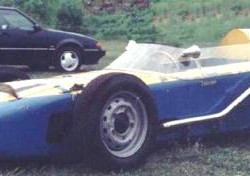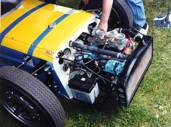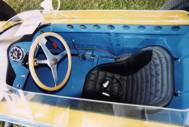SAAB
SAAB Formula Junior
In the autumn of 1960 SAAB presented a Formula Junior car of their own design. Officially, it was only a design exercise and it was said to only be intended for experimental purposes. Despite this statement, SAAB later decided to field two cars for the 1961 racing season. With this car, SAAB became the first (and only) mainstream car manufacturer to produce a Formula Junior.
Photo by “MH”
The car was designed by Rolf Mellde, who was one of the original pioneer designers of the SAAB motorcar. Mellde not only designed the car, but also performed most of the testing, which was mainly carried out on the air-fields of Såtenäs not far from the SAAB car factory in Trollhättan and Linköping next to the SAAB aeroplane factory.
The car followed the SAAB design principles with front-wheel drive and a two-stroke engine. The chassis was a steel monocoque with glass-fibre plastic front and rear body sections covering the engine and the fuel tank, respectively. The engine hung in front of the front wheel centre-line with the gearbox behind it in standard SAAB fashion resulting in a weight distribution of 70 % on the front wheels. The engine was laying flat on its side and the gearbox turned upside down compared to a standard SAAB. Suspension followed the standard layout with double A-arms up front and a rear beam axle, coil springs and telescopic dampers. Unique in a way was, however, that the coil springs worked in tension rather than compression, as was otherwise common in cars.
Photos by L-G Sjöberg
The engine was bored out to increase its capacity from 841 cc to 950 cc with fuel being fed to it through a double Solex downdraught carburettor. The carburettor was fed from two electric fuel pumps, where the driver was supposed to switch the second one on or off if the engine showed signs of starvation or flooding. Power was quoted to be 95 hp at 7000 rpm, with rumours of 100 hp having been seen on the bench. Its straight-line speed during the 1961 racing season seems to confirm that these figures were not too far from true.
Two cars were manufactured and both of them were raced during the 1961 season. The cars could be distinguished from each other by one of them having reinforcing ribs pressed into the sides of the monocoque, while the sides of the other one were completely flat. Drivers were the SAAB rally team drivers Carl-Magnus Skogh and Erik Carlsson, with Gösta Karlsson sometimes standing in for the one or the other.
The cars participated in eight races during 1961, all of them in Finland, Sweden or Denmark with mainly Scandinavian competition. Generally, they were among the 3-4 fastest runners but reliability could have been better with some 50 % DNFs. They ended the season by taking 1st and 2nd in the final Swedish championship race of the year. As said above, the cars were very fast in a straight line but suffered from severe understeer through the bends.
They met international competition of some rank on two occasions, in Karlskoga at the “Kanonloppet” in August and at the Roskilde Ring “Det Danske GP”, also in August. At Karlskoga, Gösta Karlsson was 4th in practice behind John Love, Bo Ljungfeldt, and Curt Lincoln but ahead of Tony Maggs and Denis Hulme. Unfortunately, he was to retire in the race. At Roskilde, where racing as usual comprised several heats, Skogh won his first heat beating among others Trevor Taylor and John Love. Gösta Karlsson was 3rd in his first heat behind Tony Maggs and Charlemagne Tower, but ahead of Denis Hulme. Both of them, however, retired in their respective semi-finals.
Encouraged by the performance of the cars, there were some thoughts of continuing into the next season and there were even plans to enter the Monaco GP FJ race, but in the end the decision was to call an end to the project by the end of the -61 season and the cars were retired from competition.
One car remains on display in the SAAB Museum in Trollhättan, Sweden.




